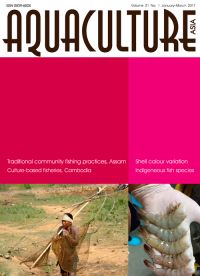Practical significance of restricted feeding regime in aquaculture
17 March 2017 | Kumar, P., Arun Sudhagar, S., V. Harikrishna and Manish Jayant | 2187 Downloads | .pdf | 143.4 KB | Better management practices, India, Nutrition and feeding
Feed is the most expensive component of an aquaculture enterprise, typically accounting for 40-60% of the operating cost depending on the intensity of production. Successful cultured fish production therefore requires optimisation of feeding practices to ensure the most economically effective growth rates and feed utilisation efficiencies. Reducing feed costs for culture practices can be achieved by taking the advantage of the phenomenon of restricted feeding strategies. Under a restricted feeding regime fish convert a greater portion of feed to body weight. Case studies of restricted feeding are presented for several species and the costs savings and other benefits are briefly discussed.
Creative Commons Attribution.

